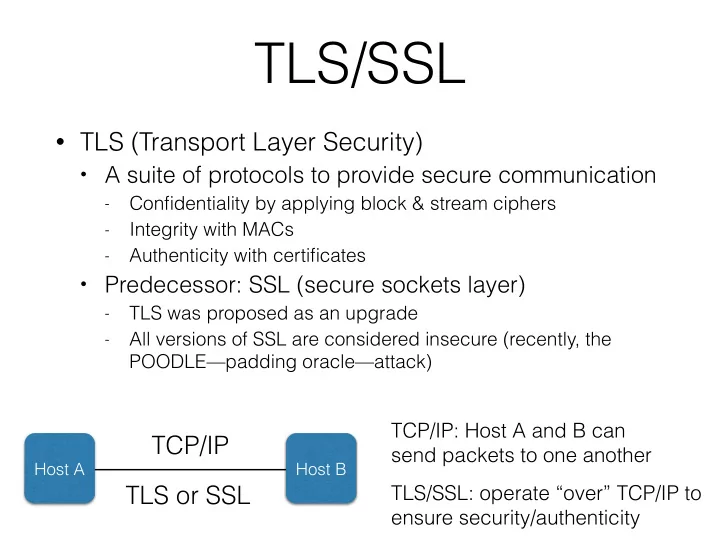

TLS/SSL • TLS (Transport Layer Security) • A suite of protocols to provide secure communication Confidentiality by applying block & stream ciphers - Integrity with MACs - Authenticity with certificates - • Predecessor: SSL (secure sockets layer) TLS was proposed as an upgrade - All versions of SSL are considered insecure (recently, the - POODLE—padding oracle—attack) TCP/IP: Host A and B can TCP/IP send packets to one another Host A Host B TLS/SSL: operate “over” TCP/IP to TLS or SSL ensure security/authenticity
TLS/SSL protocol (high level) Browser Server (initiates connection) (authenticates itself) Client hello Version, crypto options, nonce Server hello + server cert (PKs) Version, crypto options, nonce , Signed certificate containing the server’s public key PKs Server key exchange (when using DH) Client key exchange Compute Compute K based K based PreMaster secret encrypted with server’s PKs on nonces & on nonces & PreMaster PreMaster ~~~~~~~Switch to negotiated cipher~~~~~~~ Data transmission
HTTPS TCP/IP: Host A and B can TCP/IP send packets to one another Host A Host B TLS/SSL: operate “over” TCP/IP to TLS or SSL ensure security/authenticity HTTPS is HTTP operating on top of TLS/SSL Why not HTTPS everywhere?
HTTPS everywhere? • Takes more time to initiate connections • In-network services want to look at the traffic • To compress it (cannot compress encrypted traffic) • To cache it (especially if it’s static content) • To stick their own ads into it (i.e., there is pushback) • Any other ideas? • Google has moved its services over to https (even the ones you’re not logged into) • Didn’t want others “transcoding” (reducing the quality of) their videos, or sticking in their own ads
Certificates in the wild The lock icon indicates that the browser was able to authenticate the other end, i.e., validate its certificate
Certificate chain Subject (who owns the public key) Common name: the URL for which this cert is valid (can contain wildcards, e.g., *.wellsfargo.com) Issuer (who verified the identity and signed this certificate)
Wildcard certificates Certificates with wildcards are “wildcard certs”. Wildcards (*) only match a single level of a domain *.bar.com ✔ foo.bar.com ✘ not.this.bar.com The X.509 protocol (which defines the format of these certificates) advises wildcard policies (e.g., don’t allow *.*)
Serial number: Uniquely identifies this cert with respect to the issuer (look for this in CRLs) Signature algorithm: How the issuer will sign parts of the cert Not valid before/after: When to start and stop believing this cert (start & expiration dates) The public key: And the issuer’s signature of the public key
Subject Alternate Names: Other URLs for which this cert should be considered valid. (wellsfargo.com is not the same as www.wellsfargo.com) Can include wildcards, e.g., *.google.com CRL & OCSP: Where to go to check if this certificate has been revoked Non-cryptographic checksums
Root certificates
Certificate types Why are these different? This is an EV (extended validation) certificate; browsers show the full name for these kinds of certs
Proper reaction to Heartbleed 1. Patch the software 2. “Reissue” a new key (get a new one and load it onto your servers) 3. Revoke the old key Order matters! If we reissued and then patched, then our new key would be compromised, too. If we revoked first, we’d be offline.
Recommend
More recommend